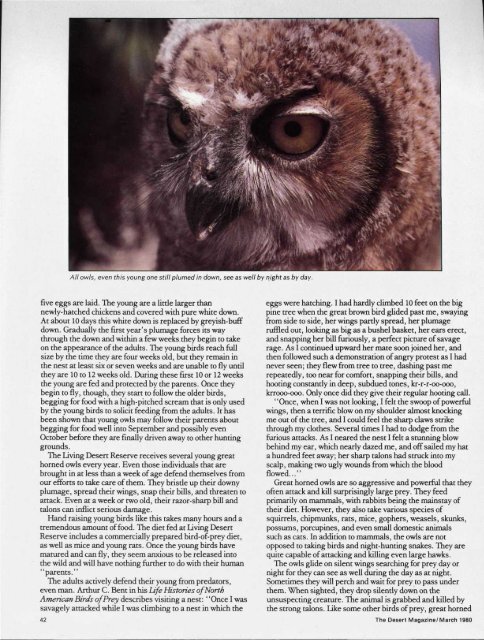BYWAYS PLUS: DATES! - Desert Magazine of the Southwest
BYWAYS PLUS: DATES! - Desert Magazine of the Southwest
BYWAYS PLUS: DATES! - Desert Magazine of the Southwest
Create successful ePaper yourself
Turn your PDF publications into a flip-book with our unique Google optimized e-Paper software.
All owls, even this young one still plumed in down, see as well by night as by day.<br />
five eggs are laid. The young are a little larger than<br />
newly-hatched chickens and covered with pure white down.<br />
At about 10 days this white down is replaced by greyish-buff<br />
down. Gradually <strong>the</strong> first year's plumage forces its way<br />
through <strong>the</strong> down and within a few weeks <strong>the</strong>y begin to take<br />
on <strong>the</strong> appearance <strong>of</strong> <strong>the</strong> adults. The young birds reach full<br />
size by <strong>the</strong> time <strong>the</strong>y are four weeks old, but <strong>the</strong>y remain in<br />
<strong>the</strong> nest at least six or seven weeks and are unable to fly until<br />
<strong>the</strong>y are 10 to 12 weeks old. During <strong>the</strong>se first 10 or 12 weeks<br />
<strong>the</strong> young are fed and protected by <strong>the</strong> parents. Once <strong>the</strong>y<br />
begin to fly, though, <strong>the</strong>y start to follow <strong>the</strong> older birds,<br />
begging for food with a high-pitched scream that is only used<br />
by <strong>the</strong> young birds to solicit feeding from <strong>the</strong> adults. It has<br />
been shown that young owls may follow <strong>the</strong>ir parents about<br />
begging for food well into September and possibly even<br />
October before <strong>the</strong>y are finally driven away to o<strong>the</strong>r hunting<br />
grounds.<br />
The Living <strong>Desert</strong> Reserve receives several young great<br />
horned owls every year. Even those individuals that are<br />
brought in at less than a week <strong>of</strong> age defend <strong>the</strong>mselves from<br />
our efforts to take care <strong>of</strong> <strong>the</strong>m. They bristle up <strong>the</strong>ir downy<br />
plumage, spread <strong>the</strong>ir wings, snap <strong>the</strong>ir bills, and threaten to<br />
attack. Even at a week or two old, <strong>the</strong>ir razor-sharp bill and<br />
talons can inflict serious damage.<br />
Hand raising young birds like this takes many hours and a<br />
tremendous amount <strong>of</strong> food. The diet fed at Living <strong>Desert</strong><br />
Reserve includes a commercially prepared bird-<strong>of</strong>-prey diet,<br />
as well as mice and young rats. Once <strong>the</strong> young birds have<br />
matured and can fly, <strong>the</strong>y seem anxious to be released into<br />
<strong>the</strong> wild and will have nothing fur<strong>the</strong>r to do with <strong>the</strong>ir human<br />
"parents."<br />
The adults actively defend <strong>the</strong>ir young from predators,<br />
even man. Arthur C. Bent in his Life Histories <strong>of</strong> North<br />
American Birds <strong>of</strong> Prey describes visiting a nest:' 'Once I was<br />
savagely attacked while I was climbing to a nest in which <strong>the</strong><br />
42<br />
eggs were hatching. I had hardly climbed 10 feet on <strong>the</strong> big<br />
pine tree when <strong>the</strong> great brown bird glided past me, swaying<br />
from side to side, her wings partly spread, her plumage<br />
ruffled out, looking as big as a bushel basket, her ears erect,<br />
and snapping her bill furiously, a perfect picture <strong>of</strong> savage<br />
rage. As I continued upward her mate soon joined her, and<br />
<strong>the</strong>n followed such a demonstration <strong>of</strong> angry protest as I had<br />
never seen; <strong>the</strong>y flew from tree to tree, dashing past me<br />
repeatedly, too near for comfort, snapping <strong>the</strong>ir bills, and<br />
hooting constantly in deep, subdued tones, kr-r-r-oo-ooo,<br />
krrooo-ooo. Only once did <strong>the</strong>y give dieir regular hooting call.<br />
"Once, when I was not looking, I felt <strong>the</strong> swoop <strong>of</strong> powerful<br />
wings, <strong>the</strong>n a terrific blow on my shoulder almost knocking<br />
me out <strong>of</strong> <strong>the</strong> tree, and I could feel <strong>the</strong> sharp claws strike<br />
through my clo<strong>the</strong>s. Several times I had to dodge from <strong>the</strong><br />
furious attacks. As I neared <strong>the</strong> nest I felt a stunning blow<br />
behind my ear, which nearly dazed me, and <strong>of</strong>f sailed my hat<br />
a hundred feet away; her sharp talons had struck into my<br />
scalp, making two ugly wounds from which <strong>the</strong> blood<br />
flowed..."<br />
Great horned owls are so aggressive and powerful that <strong>the</strong>y<br />
<strong>of</strong>ten attack and kill surprisingly large prey. They feed<br />
primarily on mammals, with rabbits being <strong>the</strong> mainstay <strong>of</strong><br />
<strong>the</strong>ir diet. However, <strong>the</strong>y also take various species <strong>of</strong><br />
squirrels, chipmunks, rats, mice, gophers, weasels, skunks,<br />
possums, porcupines, and even small domestic animals<br />
such as cats. In addition to mammals, <strong>the</strong> owls are not<br />
opposed to taking birds and night-hunting snakes. They are<br />
quite capable <strong>of</strong> attacking and killing even large hawks.<br />
The owls glide on silent wings searching for prey day or<br />
night for <strong>the</strong>y can see as well during <strong>the</strong> day as at night.<br />
Sometimes <strong>the</strong>y will perch and wait for prey to pass under<br />
<strong>the</strong>m. When sighted, <strong>the</strong>y drop silently down on <strong>the</strong><br />
unsuspecting creature. The animal is grabbed and killed by<br />
<strong>the</strong> strong talons. like some o<strong>the</strong>r birds <strong>of</strong> prey, great horned<br />
The <strong>Desert</strong> <strong>Magazine</strong>/March 1980
















